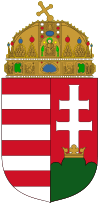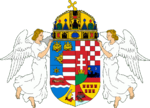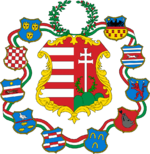Coat of arms of Hungary
| Coat of arms of Hungary | |
 |
|
| Details | |
|---|---|
| Armiger | Republic of Hungary |
| Adopted | July 3, 1990 |
| Escutcheon | left: double cross in a crown on three hills right: red and silver (Árpád) stripes |
| Supporters | none |
| Other elements | Holy Crown of Hungary |
| Earlier versions | see below |
| Use | on banknotes, buildings of governmental institutions, communal schools |
The current coat of arms of Hungary was adopted on July 3, 1990, after the end of the Communist regime.
The arms have been used before, both with and without the Crown of Saint Stephen, sometimes as part of a larger, more complex coat of arms, and many of its elements date back to the Middle Ages.
The herald is split to two parts:
- The right side consists of a silver double cross on red base, situated inside a small golden crown, the crown is placed on the middle heap of three green hills, representing mountain ranges (Mátra, Tátra, Fátra), (strictly in this order) as written in István Werbőczy's 'Tripartitium', but this is not explained there. The first explanation of the hills are from a Portuguese jesuit Antonius Macedo in his work "Divi Tutelares..." from 1687, writing: "mons essurgit numero triplex qui tres praecipuos eiusdem regni monti significant", but not naming them. Later in 18th century, two other jesuits, József Koller in "Cerographia" and Timon "Imago Novae Hungariae" state that "Alteram scuti partem Montes Regni praecipui, iique summi insigniunt. Nomen illis: Tatra, Matra, Fatra vulgare passim (...) atque omnium est cognitum". Timon adds, that the double cross is ancient symbol of Kingdom of Hungary, to which the three hills were connected. Finally, a not well-known theory for the triple hills is that it symbolizes the hills of Calvaria (Golgota), where Jesus was crucified.
- On the left side is the so-called Árpád stripes, four silver and four red stripes. It is usually said that the silver stripes represent four rivers (Duna, Tisza, Dráva, Száva).
History
 |
The most ancient element of the coat of arms is the double cross, for long time, it was thought to be the symbol of apostolic Kingdom of Hungary. Hungarian and Czech heraldics have opposed the theory that the double cross is derived from Cyrill and Method. The most accepted theory is that it is from Byzantine influence, as the cross appeared around 1190 during the reign of King Béla III who was raised in the Byzantine court. The cross appear floating in the coat of arms and on the coins from this era. |
 |
The red and white stripes were the symbol of the Árpáds and they were first used in the coat of arms in 1202 on a seal of King Imre. This seal didn't include the double cross, only the stripes, and there were nine lions on the white stripes. On the Golden Bull of King Andrew II of Hungary there were only seven lions facing each other, in the middle of the stripes linden leaves were depicted. This coat of arms was used for a short time only; Béla IV used the one with the double cross again. |
 |
When the House of Árpád became extinct and the Angevins came into power, they wanted to emphasize their legitimacy and their relation to the previous royal house by using the Árpáds' coat of arms, the red and white stripes. They combined this coat of arms with their own, using a coat of arms that resembles the one currently in use, but with the Angevins' fleur-de-lis in place of the cross. |
 |
The coat of arms with the stripes on the right and the cross on the hills on the left appeared during the reign of Louis I of Hungary (1342-1382). The crown above the coat of arms appeared during the reign of Władysław III of Poland (1440-1444). At first it was only a non-specific diadem but on the 1464 seal of Matthias Corvinus it resembled more the Holy Crown of Hungary. The final version of the coat of arms was set during the reign of King Matthias II of Hungary in the beginning of the 17th century. Its usage became regular during the reign of Queen Maria Theresa of Austria. |
 |
In the following centuries, the coat of arms of Hungary became more and more complex. It included the coats of arms of the territories that joined the Kingdom of Hungary, like Croatia, Dalmatia and Slavonia, and conquered Bosnia, but the so-called "small coat of arms" always remained the central piece. (The more complex ones were called "medium" and "large coat of arms".) The image to the left shows the medium coat of arms official (with some modifications) from the Austro-Hungarian Compromise of 1867 till the end of the First World War (1918). The outer pieces (anti-clockwise from top left) are the coats of arms of Dalmatia, Slavonia, Bosnia (added in 1915), Fiume, Transylvania, and Croatia. When Hungary became part of the Habsburg Empire, the coat of arms became a part of that of the Empire, but later it became of marginal importance and during the reign of Joseph II it was omitted from the coins. |
 |
During the Revolution and War of Independence in 1848-49, following the dethroning of the Habsburg dynasty on 14 April 1849, the Holy Crown was removed from above the coat of arms. The remaining small coat of arms is usually referred to as "Kossuth Coat of Arms" (Hungarian: Kossuth-címer) after Lajos Kossuth, Regent-President of Hungary. (Foreigners might find it a somewhat misleading name, since it was not the coat of arms of the Kossuth family.) In the large coat of arms, however, a laurel wreath replaced the crown both in the central piece and above the shield, as shown on the image to the left. |
|
After the revolution was repressed, the Hungarian coat of arms wasn't used again until the Austro-Hungarian Compromise of 1867, when the small coat of arms with the crown once more became a part of a more complex coat of arms, similar to the medium coat of arms shown above. In 1918 the Kossuth-style coat of arms was used again for a short while. The Hungarian Soviet Republic in 1919 totally abolished the traditional coat of arms and used the five pointed star on official documents. After the fall of the Soviet Republic in August 1919, the small coat of arms (with the Holy Crown) became official again until 1944. |
|
 |
During the reign of the Arrow Cross Party in the end of World War II, 1944-1945 the letter "H" (for Hungaria) and the Arrow Cross symbol were added to it. |
 |
Between 1946 and 1949 the Kossuth-style coat of arms was used, then the Communist regime introduced a new state coat of arms with a layout closely resembling that of the Soviet Union's coat of arms. Heraldically, this was not a coat-of-arms, due to the lack of shield. This symbol, known as "Rákosi badge", was not popular with the majority of the Hungarian population. |
 |
During the 1956 revolution, the "Kossuth" Coat of Arms was used again. In old newsreels, the Kossuth badge can be seen painted onto the turrets of many revolutionary tanks fighting against the Soviet invasion in Budapest streets. Although this revolution was crushed quickly by the Soviet Red Army, the new Communist government didn't want to reinstate the "Rákosi badge", and thus this coat of arms was used for about a year. |
 |
The new Socialist coat of arms was created in late 1957 by combining the general shape of the "Rákosi badge" with a small crest in the middle that had its entire area covered by the Hungarian national tricolor. This so-called "Kádár badge" conveniently omitted the cross from the non-religious Hungarian worker-state insignia, but it was quickly scrapped during the change of regime. |
Since 1990 the historical crowned small coat of arms has served as the official symbol of the Hungarian Republic.
In the first democratically elected Parliament there was considerable debate about the depiction of the Holy Crown on the coat of arms. The liberal opposition party (Alliance of Free Democrats, SZDSZ) proposed the Kossuth-style "Republican" version but the conservative government backed the historical crowned one. After the majority decision the restored coat of arms with the crown soon became generally accepted by every political party and there is a national consensus around them.
External links
- The Hungarian Coat of Arms and the law regulating its use. In Hungarian; with downloadable pictures
- The Hungarian Coat of Arms
- History of the Coat of Arms of Hungary (in Hungarian, with pictures)
- History of the Coat of Arms of Hungary from Szeged University (in Hungarian, with pictures)
See also
- Coat of Arms of Slovakia
- Hungarian heraldry
|
|||||||||||